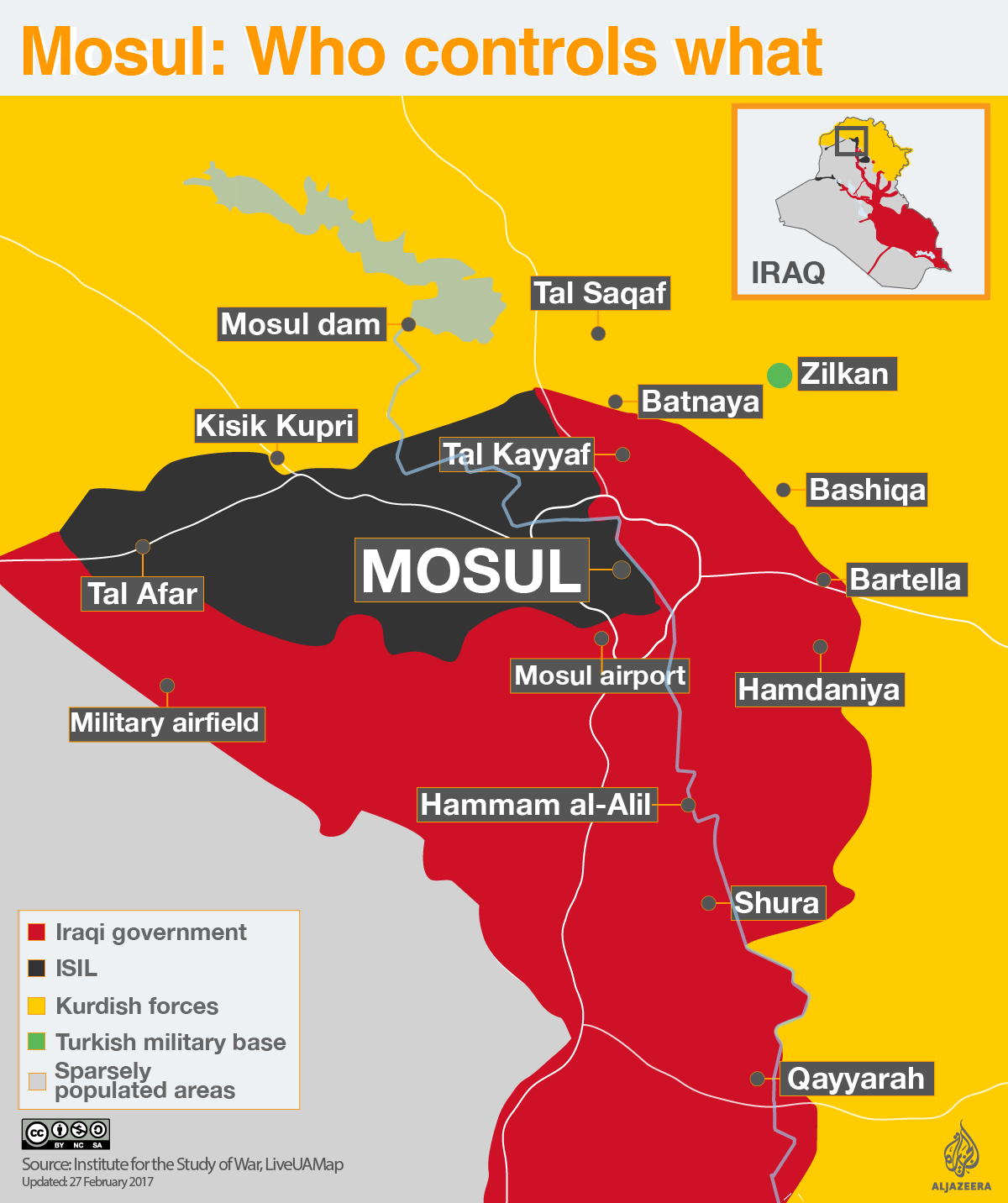Report: More than 200,000 displaced by Mosul conflict
Number of displaced swollen by 45,000 who have fled city’s west since push to seize it from ISIL began, says NGO.

More than 200,000 people have been displaced as a result of the Iraqi forces’ battle to retake the city of Mosul from ISIL that began in October, according to a Switzerland-based nongovernmental organisation.
The International Organisation for Migration (IOM) estimates, in a report released on Sunday, said 45,000 people have fled west Mosul since the push to seize it from ISIL, or the Islamic State of Iraq and the Levant group, began in February.
Keep reading
list of 4 itemsRussia-Ukraine war: List of key events, day 791
US top diplomat Blinken calls for ‘level playing field’ for firms in China
Why are nations racing to buy weapons?
More than 17,000 people arrived from west Mosul on February 28 alone, while over 13,000 came on March 3, according to the IOM.
On Saturday, a senior Iraqi government official publicly criticised UN-led efforts to aid those displaced by the west Mosul fighting, while the UN said that such assistance is the “top priority”.
WATCH: Will latest Iraqi offensive mean end of ISIL in Mosul?
“Unfortunately, there is a clear shortfall in the work of these [UN] organisations,” Jassem Mohammed al-Jaff, the minister of displacement and migration, said in a statement.
Al Jazeera’s Dekker, reporting from eastern Mosul on Sunday, said that the stream of people is continuing.
“Because the camps are operating at full capacity, the refugees are now being brought to the Kurdish regions here in northern Iraq,” she said.
“There are buses behind us that have just arrived with more arrivals. We are talking about thousands and thousands of people.”
Additionally, medical workers warned that women and children have been exposed to toxic gas near the city.
If confirmed, the use of chemical weapons and toxic agents in the fighting will amount to war crimes, the UN has said.
Push for city centre
On the ground, US-backed Iraqi forces have advanced in a new push towards Mosul’s old city centre from the western side of the Tigris River, in an attempt to drive out ISIL fighters, according to an Iraqi military spokesperson.
Smoke rose over west Mosul on Sunday as the forces advanced in a fight marked by explosions and continual automatic weapons fire.
“Federal police and Rapid Response Division forces are attacking Al Dindan and Al Dawasa neighbourhoods,” Iraq’s Joint Operations Command (JOC) said.
|
|
Al Dawasa includes the Nineveh governor’s headquarters and other government buildings. Mosul is the capital of Nineveh province.
“Counter-Terrorism Service forces are attacking Al Sumood and Tal al-Ruman neighbourhoods, and the advance is still ongoing,” the JOC said.
The Counter-Terrorism Service and Rapid Response are two special forces units that have spearheaded operations in the Mosul area, while the federal police are a paramilitary police unit.
The operation in Mosul was officially launched in October last year. In January, its eastern half was declared “fully liberated”.
The Iraqi army is also taking part in the fight for west Mosul, with the 9th Armoured Division advancing through the desert surrounding the city, aiming to cut if off from the ISIL-held town of Tal Afar, farther west.
‘Decisive battle’
Al Jazeera’s Dekker, reporting from Hassan Al Sham’s camp for displaced people, said: “What we understand is that they’re [Iraqi forces] now pushing in an area just south of the old city, an area that houses one of the government buildings.”
She said retaking the government building would be significant.
“It’s symbolic [to recapture government building], because ISIL is believed to be using that as some form of a command centre, but it’s also right at the gates of the old city of Mosul.
“Many people will probably tell you that the decisive battle for Mosul is fought, but it’s going to be very difficult.”
The streets around the historic centre, which includes the mosque in which ISIL leader Abu Bakr al-Baghdadi made his only public appearance in June 2014, will be inaccessible for Iraqi military vehicles and force government fighters to take on ISIL, also known as ISIS, in direct, on-the-ground fighting.
Iraqi government forces believe ISIL fighters are among the remaining civilian population, which aid agencies estimated to number 750,000 at the beginning of the latest offensive.
